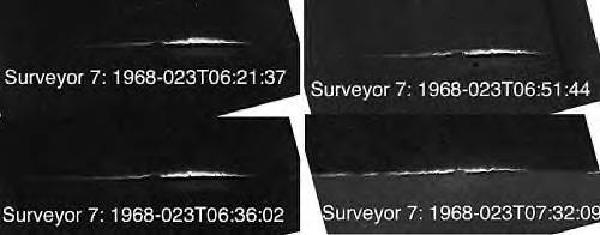
home •
about •
essential guide •
picture of the day •
thunderblogs •
news •
multimedia •
predictions •
products •
get involved •
contact
picture of the day archive subject index
Strange glow on the lunar horizon. Credit: NASA/Surveyor 7
Jun 11, 2008
Lunar Dust LevitationStatic electric charge might help to explain the glowing haze sometimes seen rising 100 kilometers above the Moon’s horizon.
Between May 1966 and January 1968, NASA launched the Surveyor missions to the Moon. Each Surveyor spacecraft weighed approximately 450 kilograms and was designed to soft-land on the lunar surface, riding the tip of a retrorocket descent engine. Surveyor 7 made one of the most intriguing discoveries when its onboard camera detected a faint glow in the lunar night, hovering over the horizon.
In 1998, the Lunar Prospector was launched from Cape Canaveral with gamma-ray spectrometer, alpha particle spectrometer, neutron spectrometer, magnetometer and electron reflectometer instrumentation. During several orbits, the spacecraft detected a surprisingly high voltage change as it passed through the magnetotail extending outward from Earth. The magnetotail is actually a part of the plasma sheath that envelops the Earth. The Moon passes through it once a month at full moon phase and the electric differential was found to occur during that passage.
The Earth is surrounded by a magnetic field that is trapped inside a cometary plasma tail that actually stretches well beyond the Moon's orbit. The Earth's magnetospheric tail points away from the Sun due to the high-speed ions streaming from the Sun.
The movement of the Moon through the ionized plasma affects the materials in the lunar regolith. Electrons accumulate and produce a negative charge on the ultra-fine dust particles, causing them to repel each other and drift off the surface.
Charge differential between the day and night side of the Moon might actually generate an ion “wind” flowing from the negatively charged night side into the more positively charged sunlit side. The negative charge on the bright surface during daylight is moderated by the photoelectric phenomenon, while it tends to build up in the darkness, forming static electricity. The charge variation between the two hemispheres has been measured at more than 1000 volts.
Earth's cometary plasma cocoon changes shape and power as electric currents from the Sun bombard our planet. It is sometimes described as a “flag waving” because of somewhat regular oscillations in the field. This means that the Moon does not simply pass through the magnetotail once and briefly, but that electric charges will brush the surface several times during each monthly encounter.
Electric currents exist in space and their effects are varied, depending on the environment. According to the Electric Universe hypothesis, electric currents from the Sun influence Martian weather by initiating gigantic dust storms and “super twisters” larger than Mt. Everest. These filamentary structures are much like those found on Earth, except larger because the ameliorating atmosphere on our planet does not exist on Mars.
In a previous Picture of the Day, activity inside tornadoes and in the magma discharges from volcanoes was found to be of electrical origin. The levitating dust and the faint glow on the lunar horizon are most likely because the Moon has no atmosphere at all, so the electric charges have greater impetus.The Electric Universe model suggests that transfer of electricity between the Earth and the Moon via the Earth's conducting plasma tail also applies to more distant Mars. Global dust storms on Mars seem to occur preferentially at opposition, and Earth's magnetotail has been detected approaching Mars. Like the Moon, Mars has no magnetosheath, so the same "tail effect" could occur on Mars, where it would influence the thin atmosphere. This would also explain the enigmatic "blue clearing" of the Martian atmosphere when viewed telescopically at opposition. The "blue clearing" refers to a blue atmospheric glow that normally renders surface features on Mars invisible through a blue filter.
By Stephen Smith
___________________________________________________________________________Please visit our Forum
The Electric Sky and The Electric Universe available now!

|
|

|
EXECUTIVE EDITORS:
David Talbott, Wallace Thornhill
MANAGING EDITORS:
Steve Smith, Mel Acheson
CONTRIBUTING EDITORS: Michael Armstrong, Dwardu Cardona,
Ev Cochrane,
C.J. Ransom, Don Scott, Rens van der Sluijs, Ian Tresman
WEBMASTER: Brian Talbott
Copyright 2008: thunderbolts.info
![]()
home •
thunderblogs •
forum •
picture of the day •
resources •
team •
updates •
contact us

